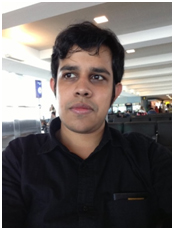INTENDED AUDIENCE
Senior B. Tech, M. Tech, Ph. D students in academia and professionals engineers/scientists working at industrial research labs, government or private, with basic background in combustion and fluid mechanics
PREREQUISITES
Fluid Mechanics, Heat Transfer
ABOUT THE INSTRUCTOR:
Prof. Swetaprovo Chaudhuri is an Assistant Professor at the Department of Aerospace Engineering, Indian Institute of Science, since June 2013. Prior to this appointment he was a research staff in the Department of Mechanical and Aerospace Engineering and Combustion Energy Frontier Research Centre at Princeton University. He earned his Ph.D. from the University of Connecticut in 2010 and B.E. from Jadavpur University in 2006, both in Mechanical Engineering. His research interests and significant contributions span over fundamental and applied aspects of turbulent combustion and functional droplets. These contributions have been disseminated through over 60 publications in top journals and international conferences.
Introduction and Chemical Thermodynamics
Combustion and its key role in Air-breathing Aero Engines.
Introduction to Classical Thermodynamics; Chemical Equilibrium; Equilibrium Constants; Heats of Formation, Reaction, Combustion; Adiabatic Flame Temperature.
Chemical Kinetics Theory
Motivation; Generalized Description of Chemical Reactions; Law of Mass Action; QSS and PEA Approximations; Arrhenius Law; Reaction Rate Constant; Collision Theory; Transition State Theory; Lindemann Theory; Generalized Description of Chain Reaction Mechanism.
Fuel Oxidation Mechanisms
Practical Fuels; Importance of Detailed Reaction Mechanisms; Oxidation Mechanism of Hydrogen and Z-curve;Oxidation of Carbon Monoxide; Methane Oxidation and Auto-ignition; Low-Temperature Combustion; NOx Formation Mechanisms; Soot Formation Mechanisms; Mechanism Reduction
Transport Phenomena
Transport in Multicomponent Systems; Importance of Diffusion Processes and Derivation of Diffusion Coefficients.
Governing Equations
Reynolds Transport Theorem and Brief Derivation of Mass, Momentum, Species and Energy Equations; Constitutive Relations; Isobaric Assumption; ASimplified Diffusion Controlled System; Coupling Function Formulation.
Non Premixed Flames
1D Chambered Flame Analysis, Stefan Convection, Droplet Evaporation and Combustion.
Premixed Flames
Rankine Hugoniot Relations – Deflagration and Detonation; 1D Laminar Premixed Flame: Phenomenological Derivation of Flame Speed, Frank Kamenetskii Analysis of Flame Speed, Methods of Flame Speed Measurement, Chemical Structure of Flames.
Premixed Flames and Limit Phenomena
Quenching Distance and Ignition; Adiabatic Thermal Explosion, Semenov Criteria, S-curve Concept, Premixed Flame Extinction by Heat Loss.
Turbulence and Introduction to Turbulent Combustion
Fundamentals of Turbulence: ReynoldsAveraged Navier-Stokes Equations: Turbulence Kinetic Energy Production and Dissipation; Energy Cascade; Favre Averaging; Mean Reaction Rate Closure Problem; EBU, EDC Closures, and their Limitations.
Turbulent Non-Premixed Combustion
Governing Equations in Mixture Fraction Space; Flamelet Model; Introduction to TPDF and CMC Models.
Turbulent Premixed Combustion
Turbulent Premixed Combustion Regime Diagrams; G Equation; Turbulent Flame Speed; Fundamentals of Turbulence-Flame Interaction.
Gas Turbine Combustors
Liquid Jet Breakup; Basics of Swirling Flows and Flames; Gas Turbine Combustors Design Considerations; Introduction to Thermoacoustic Instabilities.
Flame Stabilization in Afterburners
Mechanism of Flame Stabilization and Blowoff in Prototypical Afterburner using Laser-Based Diagnostics.
Scramjet Combustors
Introduction to Scramjets; Scramjet Combustor Design Considerations, Challenges in Achieving Steady Combustion in Scramjets.
SUGGESTED READING
CERTIFICATE: